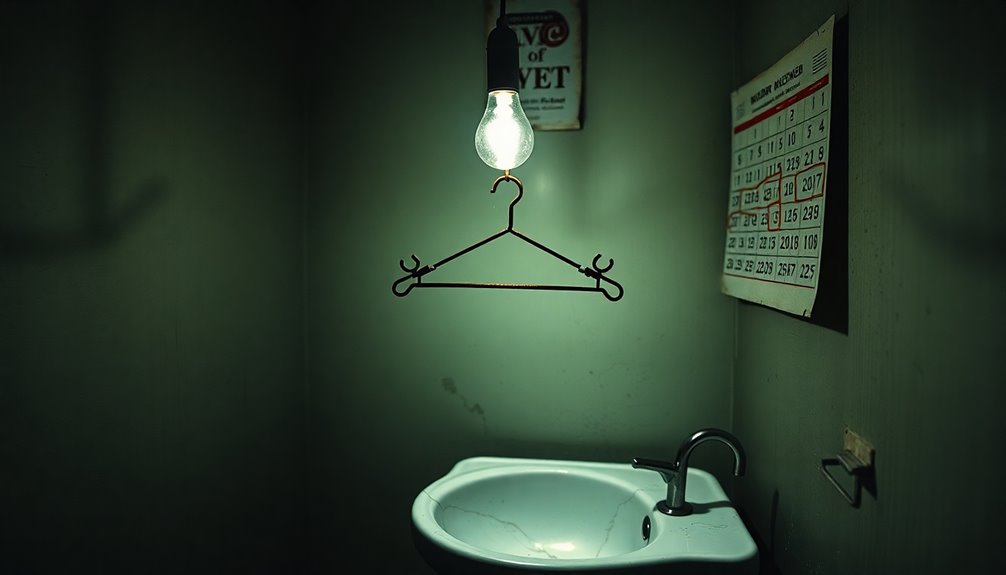The coat hanger is a powerful symbol of the dangers women faced from illegal abortions before Roe v. Wade. It highlights a chilling history marked by desperate measures and horrifying consequences, like severe health risks and even death. Today's debates around abortion mirror this troubling past, especially as restrictive laws resurface, disproportionately affecting marginalized communities. As you explore this topic, you'll find that the realities of access and safety remain critical in shaping modern discussions about women's health and reproductive rights. Understanding these issues can help illuminate the stakes in today's polarized climate.
Key Takeaways
- The coat hanger symbolizes the dangerous, unsafe abortions women faced before legalization, representing desperation and severe health risks.
- Misrepresentation of coat hanger abortions in modern discourse can obscure the reality of professional illegal abortions and perpetuate harmful misconceptions.
- Historical data reveals that restrictive laws led to unsafe abortion practices, resulting in high maternal mortality rates and health complications.
- Current debates on abortion access reflect political polarization, with a significant divide between those advocating for reproductive rights and those opposing them.
- Advocacy for safe abortion practices is crucial to ensure women's health and autonomy, particularly in marginalized communities affected by economic disparities.
Historical Context of Self-Induced Abortions

Self-induced abortions have a long and troubling history in the United States, reflecting a desperate response to restrictive laws and societal pressures. Since the early 20th century, women have resorted to dangerous methods, using items like coat hangers, knitting needles, and crochet hooks. In tribal societies from 1600 to 1900, various plants served as abortifacients, while some women turned to toxic substances like arsenic or inflicted harm through deliberate falls. Midwives often played a crucial role in these situations, helping women when licensed doctors wouldn't.
The legal landscape exacerbated the issue. Between 1867 and 1973, abortion was largely illegal, prompting a surge in self-induced procedures. Anti-abortion laws, including the Comstock Act of 1873, restricted access to information about reproductive health. As states began passing laws to ban abortion by the late 1860s, women continued to seek ways to terminate pregnancies, often in unsafe environments. Historical setbacks demonstrate that even after the legalization of abortion in 1970, economic constraints and laws like the Hyde Amendment limited access for many, particularly women of color and those from lower socioeconomic backgrounds, forcing them back to self-induced methods.
Medical Risks and Complications

When women resort to unsafe abortion methods, they expose themselves to a range of severe medical risks and complications. One of the most alarming risks is severe hemorrhage, which can occur due to uterine perforation or laceration of uterine arteries. If you experience significant blood loss, it can lead to shock and even death without prompt medical attention. Non-sterile instruments, like coat hangers, can also introduce dangerous bacteria into the uterus, leading to infections and sepsis. Untreated infections can escalate into septic shock or pelvic inflammatory disease (PID), significantly raising your risk of infertility.
Further, sharp objects can cause direct damage to the uterus and surrounding organs, like the bowel, potentially requiring major surgeries, including a hysterectomy. Long-term health consequences can be devastating as well. You might face permanent disabilities that affect your ability to carry a child in the future, and chronic health issues may emerge from untreated infections. The emotional and psychological trauma from these experiences can linger long after the physical wounds heal. Unsafe abortion remains a leading cause of maternal mortality, underscoring the importance of prioritizing safe and legal abortion methods to safeguard your health and future.
Social and Economic Disparities

Abortion access isn't just a matter of personal choice; it's deeply intertwined with social and economic disparities that disproportionately affect marginalized communities. If you're from a lower economic background, you likely face significant barriers to obtaining safe and legal abortions. Financial constraints can magnify the distress of an unwanted pregnancy, leaving you with fewer options. While wealthier individuals can travel or obtain "therapeutic" abortions, many others struggle to finance their procedures, even post-legalization.
Women of color, especially, encounter increased challenges. With 59% of abortions in 2020 involving Black and Hispanic individuals, the racial and ethnic disparities are stark. Often underinsured and lacking access to prenatal care, these women are further marginalized by systemic issues, including high maternal mortality rates. Legal access to safe abortion services has been shown to correlate with lower maternal mortality rates, underscoring the importance of addressing these disparities.
Class inequalities also play a crucial role; poorer women often seek secrecy in their abortion journeys to avoid social stigma. The intersection of these factors creates a complex web that complicates access to care. Addressing these disparities requires a comprehensive approach that acknowledges the varied influences of race, class, and economic status on abortion access and outcomes.
Symbolism of the Coat Hanger

Throughout the history of reproductive rights, the coat hanger has emerged as a chilling symbol of the dangers faced by women before the legalization of abortion. This object represents a dark time when women resorted to unsafe methods to terminate pregnancies, risking their health and lives in the process. The coat hanger serves as a stark reminder of the desperation that characterized the pre-Roe v. Wade era, where many women faced significant health risks and fatalities.
In pro-choice movements, the coat hanger has become a powerful emblem, evoking visceral reactions and highlighting the dangers of restricting abortion access. You'll see it in protests, art, and political cartoons, often used to stress the importance of safe, legal abortions. Activists have incorporated it into slogans and accessories to amplify their message. Increased rates of unsafe abortions in restrictive states further underscore the coat hanger's relevance in current debates.
However, this symbol isn't without controversy. Critics argue it misrepresents the current abortion landscape, promotes graphic imagery, and oversimplifies complex histories. As perspectives evolve, many advocates are calling for a shift away from the coat hanger to focus on empowering representations of safe abortion options. This change aims to reflect the realities of accessible, clinical abortion services and the need for informed choices.
Misrepresentation in Modern Discourse

The coat hanger, while a potent symbol of past struggles for reproductive rights, can mislead contemporary discussions about abortion. This imagery creates a distorted narrative about the methods women supposedly used for self-induced abortions, implying that coat hangers were common tools. In reality, most illegal abortions were carried out by professionals, not desperate women using household items. Historical records reveal that the prevalent method involved injecting fluid into the womb, far removed from the coat hanger myth.
Moreover, claims about widespread fatalities from coat hanger abortions lack substantial evidence. Most statistics regarding abortion-related deaths before legalization are exaggerated or unreliable. By relying on this outdated symbol, you risk perpetuating a harmful misconception that without legal options, women will resort to dangerous self-induction methods. Additionally, the rise of medical abortion options has significantly increased safety and accessibility, further distancing the current landscape from past practices.
This narrative detracts from the more nuanced and accurate representation of modern abortion care, which is safe and clinically supervised. It can also be disrespectful to those who experienced unsafe abortions in the past, trivializing their suffering. To foster informed discussions, it's crucial to retire the coat hanger symbol and focus on the real complexities surrounding abortion today.
Contemporary Relevance of Abortion Debates

In today's political landscape, abortion debates aren't just conversations; they're pivotal flashpoints that shape voter behavior and influence election outcomes. The Supreme Court's decision in *Dobbs v. Jackson Women's Health Organization* has intensified polarization, making abortion a litmus test for candidates. If you're a voter, you might notice how conservative candidates prioritize opposition to abortion, while liberal candidates champion reproductive rights as essential to gender equality.
These debates have tangible economic implications too. With abortion access tied to women's workforce participation, restrictive measures can hinder economic progress. Secretary of the Treasury Janet Yellen even warned that eliminating the right to abortion could set women back decades, affecting the overall economy. Additionally, the debate has been fueled by the recent overturning of Roe v. Wade, which has led to stricter abortion laws in many states.
Public opinion remains complex; a majority supports abortion access, yet there's a striking partisan divide. While nearly 90% of Democrats back abortion rights, only 21% of Republicans do. This divide fuels ongoing legal and legislative battles, with states enacting various restrictions. As you engage in these discussions, remember that abortion isn't just a personal issue—it's intertwined with broader societal, economic, and political dynamics that impact everyone.
Historical Records and Case Studies

Historical records reveal a complex evolution of abortion practices and laws in the United States. When the American Medical Association (AMA) formed in 1847, it initiated a campaign that scrutinized midwives and their services, setting the stage for the criminalization of abortion. By the late 1860s, states began enacting laws that restricted access, culminating in the 1873 Comstock Act, which criminalized any information related to birth control and abortion. By 1910, every state had made abortion illegal at all stages of pregnancy.
Women facing unwanted pregnancies often resorted to dangerous methods, using sharp objects like knitting needles and crochet hooks to self-induce abortions. These methods frequently resulted in serious complications, including uterine perforation and severe trauma. The grim reality was highlighted in surgical journals, documenting the health risks women faced. Self-induced abortions often resulted in serious injuries, emphasizing the desperate circumstances that many women encountered.
The criminalization of abortion not only drove the practice underground but also disproportionately affected poor women and women of color. Public health data from the 1930s showed nearly 2,700 women died from unsafe, illegal abortions, which accounted for 18% of maternal deaths. These historical insights reveal the dire consequences of restrictive abortion laws and underscore the need for informed discussions.
Emphasizing Safe Abortion Options

Safety in abortion care is paramount for ensuring women's health and well-being. Safe abortions adhere to the World Health Organization's guidelines, using methods appropriate for the pregnancy's gestational period and performed by trained professionals. These procedures are among the safest medical interventions, with complications being rare when conducted properly. Unsafe abortion is a leading cause of maternal death, with WHO estimating 4.7% to 13.2% of maternal deaths from unsafe abortions.
You have several safe abortion options available. Medication abortion, for instance, is effective 97% of the time when used correctly, allowing for a private experience. Vacuum aspiration offers a gentle in-clinic procedure, while dilation and evacuation (D&E) ensures thorough care. Telemedical abortions enable you to manage the process at home safely, provided you have the right information and support.
Access to trained providers is crucial to minimize risks. They ensure the procedure is performed safely and that you receive appropriate care. Unfortunately, restrictive abortion laws can limit access to these providers, increasing the likelihood of unsafe abortions, particularly for marginalized groups.
To improve safety in abortion care, we must advocate for accessible, skilled healthcare and dismantle barriers that prevent women from receiving safe options. Your health and choices matter, and ensuring safe abortion access is essential for all.
Frequently Asked Questions
What Legal Changes Affected Abortion Access in the 1970S?
In the 1970s, key legal changes dramatically affected abortion access. You saw the landmark Roe v. Wade ruling establish abortion as a constitutional right, leading to the decriminalization of the procedure nationwide. This uniform legal standard replaced varied state laws, ensuring safer access. As a result, you benefited from reduced health risks associated with illegal abortions and experienced greater reproductive freedom, although challenges remained, particularly for marginalized communities.
How Do Abortion Pills Compare to Historical Methods?
When you compare abortion pills to historical methods, you'll find significant differences in safety and effectiveness. Abortion pills, like mifepristone and misoprostol, have a high success rate of 94-99% with minimal major complications. In contrast, historical methods often involved dangerous and painful procedures, leading to severe injuries or death. Medical abortions allow you to manage the process privately and safely, unlike the risky techniques of the past that put many women's lives at risk.
What Role Do Activists Play in Modern Abortion Debates?
Activists play a crucial role in modern abortion debates by mobilizing support and influencing public opinion. They organize events, share personal stories, and advocate for policy changes that reflect their beliefs. You'll find that young voters, especially Gen Z, are particularly engaged, using social media to amplify their voices. By normalizing discussions around abortion, activists reduce stigma and encourage more individuals to participate in the conversation, shaping the future of reproductive rights.
How Can Individuals Support Safe Abortion Access Today?
You can support safe abortion access today by advocating for policies like the Women's Health Protection Act and urging lawmakers to protect reproductive rights. Donate to abortion funds that assist with travel and lodging, and educate yourself about local laws. Share accurate information about safe abortion methods and engage in community events to raise awareness. By activating your networks and spreading the message that access is essential, you can make a significant impact.
What Are the Psychological Effects of Seeking Self-Induced Abortions?
If you seek a self-induced abortion, you might experience immediate anxiety, distress, and guilt due to the dangerous methods involved. The physical pain can leave emotional scars, leading to long-term issues like PTSD, depression, and low self-esteem. You may also face challenges in relationships and heightened feelings of shame. The stigma surrounding abortion can further complicate your mental health, making it crucial to seek support from understanding professionals and loved ones.
Conclusion
As you dive into the chilling history of hanger abortions, you can't ignore the stark realities of today's abortion debates. Understanding the medical risks, social disparities, and the symbolism behind the coat hanger is crucial. It's vital to recognize the importance of safe, legal abortion options to prevent history from repeating itself. By engaging in informed discussions, you can help advocate for reproductive rights and ensure that everyone has access to safe healthcare choices.









